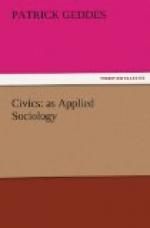have been taken towards the purification of the other.
That the city and university pre-eminently associated
with the invention of the steam-engine, and consequently
with the advent of the industrial revolution throughout
the world, should, a century later, have produced
a scarcely less pre-eminent leader of applied science
towards the command of electricity is thus no isolated
coincidence. And as political economy, which is
ever the theory corresponding to our phase of industrial
practice, and there some of its foremost pioneers,
and later its classical exponent, Adam Smith himself,
so once more there are signs at least of a corresponding
wave of theoretic progress. Students of primitive
civilisation and industry have now long familiarised
us with their reinterpretation of what was long known
as the stone age, into two very distinct [Page:
107] periods, the earlier characterised by few and
rough implements, roughly used by a rude people, the
second by more varied tools, of better shape, and finer
edge, often of exquisite material and polish.
We know that these were wielded more skilfully, by
a people of higher type, better bred and better nourished;
and that these, albeit of less hunting and militant
life, but of pacific agricultural skill, prevailed
in every way in the struggle for existence; thanks
thus not only to more advanced arts, but probably
above all to the higher status of woman. This
distinction of Paleolithic and Neolithic ages and
men, has long passed into the terminology of sociological
science, and even into current speech: is it
too much then, similarly, to focus the largely analogous
progress which is so observable in what we have been
wont to generalise too crudely as the modern Industrial
Age? All are agreed that the discoveries and
inventions of this extraordinary period of history
constitute an epoch of material advance only paralleled,
if at all, in magnitude and significance by those
of prehistory with its shadowy Promethean figures.
Our own advance from a lower industrial civilisation
towards a higher thus no less demands definite characterisation,
and this may be broadly expressed as from an earlier
or Paleotechnic phase, towards a later or more
advanced Neotechnic one. If definition
be needed, this may be broadly given as from a comparatively
crude and wasteful technic age, characterised by coal,
steam, and cheap machine products, and a corresponding
quantitative ideal of “progress of wealth
and population”—towards a finer civilisation,
characterised by the wider command, yet greater economy
of natural energies, by the predominance of electricity,
and by the increasing victory of an ideal of qualitative
progress, expressed in terms of skill and art, of hygiene
and education, of social polity, etc.




